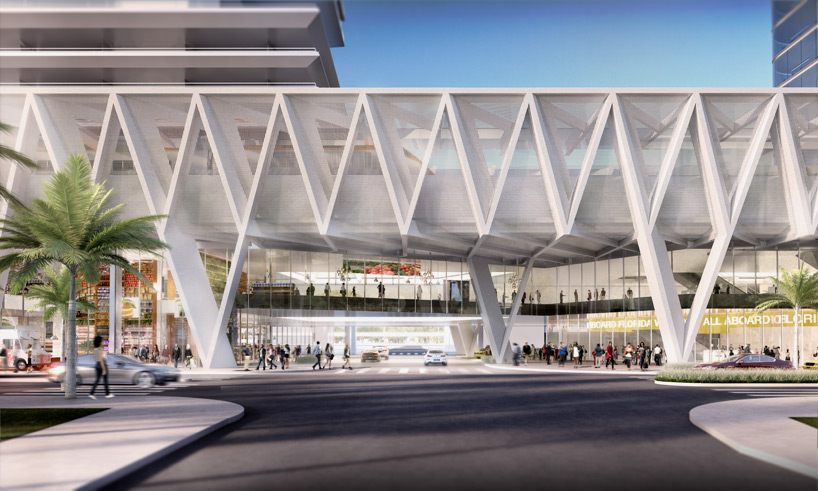As a part of the overarching project All Aboard Florida, Skidmore, Owings, and Merrill has designed a multimodal transit hub for Miami, one of three that will eventually connect Miami to Orlando by train.
The station will serve an estimated 12 million Floridians each year, and is meant to eliminate at least three million car trips each year.
The main terminal is located about 50 feet above street level. The space below will be full of retail spaces; the elevated terminal will allow for all roadside properties to remain leaseable, according to designboom.
“This project is a true celebration of the power and potential of transit-oriented development,” Roger Duffy, Design Partner at SOM, said in a press release. “We are excited to continue working with All Aboard Florida to realize this vibrant infrastructural undertaking, unparalleled in its scope, scale, and vision.”
Passenger service is expected to begin in 2016.
Here is SOM's full press release on the project:
In a ceremony today, Miami Mayor Tomás Pedro Regalado, Miami-Dade County Mayor Carlos A. Gimenez, and All Aboard Florida executives unveiled designs for All Aboard Florida’s new multimodal hub for Miami, planned and designed by Skidmore, Owings & Merrill LLP (SOM). In addition to the Miami hub, SOM is also planning and designing All Aboard Florida’s passenger stations in Fort Lauderdale and West Palm Beach, which will be unveiled at a later date.
All Aboard Florida is the only privately owned, operated and financed project of its kind being developed in the United States today. All Aboard Florida’s 235-mile network of rail lines will connect South Florida to Orlando by utilizing the current rail infrastructure for the Florida East Coast Corridor between Miami and the Space Coast and creating new tracks into Central Florida. The transformational infrastructure project will provide a vital new service for Florida residents, business people, and visitors and eliminate more than three million car trips from the region’s roadways each year. Passenger service is anticipated to begin in late 2016.
“An estimated 12 million travelers will benefit from the Miami station,” says Michael Reininger, President and Chief Development Officer, All Aboard Florida. “All Aboard Florida provides a fast and convenient transit alternative for this growing demand and need, while integrating transportation infrastructure with mixed use development to serve as a catalyst for transformation and economic vitality in a city that is quickly becoming a model for urban living today.”
“This project is a true celebration of the power and potential of transit-oriented development,” states Roger Duffy, Design Partner at SOM. “We are excited to continue working with All Aboard Florida to realize this vibrant infrastructural undertaking, unparalleled in its scope, scale, and vision.” Florida?based Zyscovich Architects is serving as the project’s Associate Architect and Planner.

renderings courtesy SOM / © SOM
SOM’s three stations will be key portals within All Aboard Florida’s rail system. Envisioned not only as gateways to their respective cities, but also as iconic destinations, the terminals will be filled with spaces to shop, eat, and meet. In downtown Miami, SOM has responded to an extraordinarily challenging and dense site by elevating the railways 50 feet in the air. Retail spaces are vertically layered beneath the soaring tracks and ample use of glass will give the station a shimmering, lightweight quality. This innovative solution allows thru-streets to remain open to traffic and for valuable streetfront real estate to remain leasable. Moreover, this bold architectural gesture creates a landmark terminal—a symbol of a 21st-century Miami.
As pieces of urban infrastructure, the stations are positioned to become centers of gravity for significant urban redevelopment. Economists estimate that All Aboard Florida will pump more than $6 billion into the Florida economy over the next eight years.
“Florida is poised to become the third largest state in the nation due to population growth,” said Kristopher Takacs, SOM Project Manager. “All Aboard Florida responds to this swelling demand by providing a fast and convenient transit alternative to the state’s highways and airport terminals. By integrating this transportation infrastructure with future mixed-use development, the terminals will be the catalysts to transform these cities locally, regionally, and globally.”
SOM has more than seven decades of experience in planning, designing, and implementing large?scale city-building projects that combine transportation infrastructure with urban mixed-use development. In the past twenty years alone, SOM has completed more than $5 billion dollars worth of transportation construction projects around the world, including complex intermodal and multimodal facilities, subway and rail stations, ferry terminals, the design of entire airports and more than a dozen airport terminals.

renderings courtesy SOM / © SOM
All Aboard Florida is an intercity passenger rail project being developed by Florida East Coast Industries, Inc. (FECI) — owner of Florida’s premier passenger rail corridor — that will connect Miami to Orlando with intermediate stations in Fort Lauderdale and West Palm Beach. This rail service will give Floridians and visitors a viable transportation alternative to congested highways and airport terminals. All Aboard Florida will provide a high?quality experience for passengers and will be the first privately owned, operated, and maintained passenger rail system in the United States. For more information, visit www.AllAboardFlorida.com.
About Florida East Coast Industries, Inc.
Florida East Coast Industries, Inc. (FECI), through its subsidiaries and affiliates, is one of Florida’s oldest and largest integrated, full?service real estate and infrastructure companies. Headquartered in Coral Gables, FL, FECI has a rich history dating back over a century when Henry Flagler first established the company which became a pioneer in the development of Florida’s eastern coast.
About Zyscovich Architects
Zyscovich Architects (Zyscovich) is an international master planning, architecture, and interior design firm with offices in Miami, West Palm Beach, Orlando, New York City, Bogotá, and Tobago. The firm's innovative approach to planning, Real Urbanism™, embraces the history and economics of a community to create a unique vision that brings tangible value and improved quality of life to the area. The firm's commitment to customized solutions is also evident in its award winning architectural design work for both public and private clients. Zyscovich's broad range of experience includes large?scale mixed?use, transportation, educational, commercial, retail, multi?family residential, and hospitality projects.
About Skidmore, Owings & Merrill LLP
Skidmore, Owings & Merrill LLP (SOM) is one of the leading architecture, interior design, engineering, and urban?planning firms in the world, with a 75?year reputation for design excellence and a portfolio that includes some of the most important architectural accomplishments of the 20th and 21st centuries. Since its inception, SOM has been a leader in the research and development of specialized technologies, new processes and innovative ideas, many of which have had a palpable and lasting impact on the design profession and the physical environment. The firm’s longstanding leadership in design and building technology has been honored with more than 1,700 awards for quality, innovation, and management. The American Institute of Architects has recognized SOM twice with its highest honor, the Architecture Firm Award—in 1962 and again in 1996. The firm maintains offices in New York, Chicago, San Francisco, Los Angeles, Washington, D.C., London, Hong Kong, Shanghai, Mumbai and Abu Dhabi.
Related Stories
| Apr 5, 2011
Top 10 Buildings: Women in Architecture
Making selections of top buildings this week led to a surprising discovery about the representation of women in architecture, writes Tom Mallory, COO and co-founder, OpenBuildings.com. He discovered that finding female-created architecture, when excluding husband/wife teams, is extremely difficult and often the only work he came across was akin to interior design.
| Apr 5, 2011
What do Chengdu, Lagos, and Chicago have in common?
They’re all “world middleweight cities” that are likely to become regional megacities (10 million people) by 2025—along with Dongguan, Guangzhou, Hangzhou, Shenzhen, Tianjin, and Wuhan (China); Kinshasa (Democratic Republic of the Congo); Jakarta (Indonesia); Lahore (Pakistan); and Chennai (India), according to a new report from McKinsey Global Institute: “Urban World: Mapping the economic power of cities”.
| Mar 30, 2011
China's low-carbon future city
In 2005, the Chinese government announced its target to reduce energy consumption per GDP unit by 20% by the year 2010. After a multi-billion investment, that target has been reached. The Chinese Climate Protection Program’s goal to increase energy efficiency, develop renewable energies, and promote energy savings while reducing pollutant emissions and strengthening environmental protection is reflected in the “Future City” by SBA Design.
| Mar 30, 2011
Is the AEC industry at risk of losing its next generation leaders without better mentoring?
After two or three horrifying years for the AEC industry, we are finally seeing the makings of a turnaround. However, data developed by Kermit Baker as part of the AIA Work-on-the-Boards survey program indicates that between 17% and 22% of design firms are eliminating positions for interns and staff with less than six years of experience. This data suggests the industry is at risk of losing a large segment of its next generation of leaders if something isn't done to improve mentoring across the profession.
| Mar 29, 2011
City's design, transit system can ease gas costs
Some cities in the U.S. are better positioned to deal with rising gas prices than others because of their design and transit systems, according to CEOs for Cities, a Chicago-based nonprofit that works to build stronger cities. The key factor: whether residents have to drive everywhere, or have other options.
| Mar 29, 2011
Chicago’s Willis Tower to become a vertical solar farm
Chicago’s iconic Willis Tower (formerly the Sears Tower) is set to become a massive solar electric plant with the installation of a pilot solar electric glass project.
| Mar 29, 2011
Read up on Amazon.com's new green HQ
Phase IV of Amazon’s new headquarters in Seattle is nearly complete. The company has built 10 of the 11 buildings planned for its new campus in the South Lake Union neighborhood, and is on-track for a 2013 grand opening.
| Mar 29, 2011
Portuguese architect Eduardo Souto de Moura wins Pritzker Architecture Prize
Portugese architect Eduardo Souto de Moura, whose precisely-honed buildings reflect the influence of the late Chicago modernist Mies van der Rohe, is the 2011 winner of the Pritzker Architecture Prize, the field's highest honor.
| Mar 25, 2011
Qatar World Cup may feature carbon-fiber ‘clouds’
Engineers at Qatar University’s Department of Mechanical and Industrial Engineering are busy developing what they believe could act as artificial “clouds,” man-made saucer-type structures suspended over a given soccer stadium, working to shield tens of thousands of spectators from suffocating summer temperatures that regularly top 115 degrees Fahrenheit.













